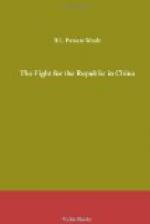Secondly, while Koreans are now Japanese subjects, it is contended by the Chinese that the particular Koreans inhabiting the Yenchi region are, as regards China, in a different position from Japanese subjects elsewhere. These Koreans enjoy the rights of free residence and of cultivating and owning land in the interior of China, rights denied to other foreigners, including Japanese who, even by the new treaty, may only lease land in South Manchuria. For this exceptional privilege, they are subject to the jurisdiction of Chinese laws and Chinese courts, a duty not imposed on other foreigners. It would be “blowing hot and cold at the same time” in the language of English lawyers if it is sought to enjoy the special privileges without performing the duties.
Thirdly, Japanese under the Treaty of 1915 are required to register their passports with the local authorities. On the other hand, Koreans in Yenchi have never been nor are they now required to procure passports. This would seem to be conclusive proof that Koreans in that region are not within the provisions of the treaty of 1915 but are still governed by the Tumen Kiang Agreement.
The question is something more than one of academic or even merely judicial importance. As has been stated, the Koreans in Yenchi outnumber the Chinese and the only thing that has kept the region Chinese territory in fact as well as in name is the possession by the Chinese of jurisdiction over every inhabitant, whether Chinese or Korean. Were China to surrender that jurisdiction over a majority of those inhabitants, it would be tantamount to a cession of territory.
2 Degrees Macao
The dispute between China and Portugal over the Macao question has been one of long standing. The first treaty of commerce signed between them on August 13,1862, at Tientsin, was not ratified in consequence of a dispute respecting the Sovereignty of Macao. By a Protocol signed at Lisbon on March 26, 1887, China formally recognized the perpetual occupation and government of Macao and its dependencies by Portugal, as any other Portuguese possession; and in December of the same year, when the formal treaty was signed, provision was made for the appointment of a Commission to delimit the boundaries of Macao; “but as long as the delimitation of the boundaries is not concluded, everything in respect to them shall continue as at present without addition, diminution, or alteration by either of the Parties.”
In the beginning of 1908, a Japanese steamer, the Tatsu Maru, engaged in gun-running was captured by a Chinese customs cruiser near the Kau-chau archipelago (Nove Ilhas). The Portuguese authorities demanded her release on the ground that she was seized in Portuguese territorial waters thus raising the question of the status of the waters surrounding Macao.




